#1837-1901
Explore tagged Tumblr posts
Text

Walter Field A poppy field 1878 oil on canvas 32.4 x 53.5 cm.
225 notes
·
View notes
Text
Victoria ruled the world's greatest empire & left her name everywhere

Queen Victoria 1837 - 1901
#Queen Victoria#British Empire#VRI#monarchy#1837-1901#pink maps#House of Hanover#royal portraits#Empress of India#archival photo#colourised#Victoria Regina Imperatrix#UK
43 notes
·
View notes
Text


genderfluids your pro neighbor because the gender in parkciv is parkour- Who needs gender roles when you've got parkour anyways-
#Pro neighbor#parkour civilization#this all spawned from me seeing their minecraft skin in the movie and going “Oh do they have space buns? Neat!” to only realize that no tha#that is probably not what the skin was probably intending-#but it wasstuck in my head so you guys get it now#I like Pro neighbor and noob neighbor and I was gonna draw noob neighbor but I have to get a screenshot of him and also I got distracted#distracted by what you may ask? It may or may not be a polykour thing#cause the only ship I've drawn is mavbo I need to feed the polykour community and I need to fill my parkciv doodle page anyways#fanart#parkour civilization fanart#pkciv#pkciv fanart#parkciv#I think that should probably be enough tags#madi's art :>#also I've decided to call them Victor/Victoria/Vic for the sillies cause he reminds me of the victorian era#he also reminds me of a detective and the adventures of sherlock holmes was published in the victorian era sooo#because the victorian era ran from 1837 to 1901 and the adventures of sherlock holmes was published in 1892 according to google SOOOOOO#my brain connecting all the dots fr fr#evbo's parkour pro neighbor#Evbo's pro neighbor#because apparently I did not add enough tags oops
75 notes
·
View notes
Note
Are you going to get a driving license? Wait, do you actually have papers? How are you doing in the meantime, you taking the tube for now?
(It's so funny imagining this classy victorian twink in the subway of all places)
I could hardly get a provisional driver's license, let alone one that actually permits me to drive alone, given the legal situation I am in. It turns out that appearing people is considerably more difficult than disappearing them.
Yes, I'm utilising public transport at present. It's rather convenient. I find that I prefer the buses to the Underground, but I make use of both as necessary.
And for the record, I am in possession of enough clothes matching the fashion of this era that I can blend in with the masses perfectly well, thank you.
#Google says that Queen Victoria reigned between 1837-1901. The era is sometimes defined as 1820-1914.#The Institute was founded in 1818. I do not wish to be pedantic but given that this is after my time—you have the wrong era.#tma rp
4 notes
·
View notes
Text
New e-books....
I just downloaded all 13 books in “The Haunting of Hadlow House” series by Amy Cross. I was fixing to buy them all in paperback form but I found out it was going to cost me a lot more money. The series is about a specific house that is haunted, however, each book tells a different story about that house at a different point in time. I can’t wait to get started on this series…. 1689 by Amy Cross…
#1689#1722#1775#1800#1837#1885#1901#1918#1926#1939#1966#1999#2024#Amy Cross#digital#e-book#e-books#Kindle#Kindle Edition#Kindle Fire#The Haunting of Hadlow House
1 note
·
View note
Text
"Покинутая Ариадна"
Поль Нантей (Франция, 1837 - 1901)
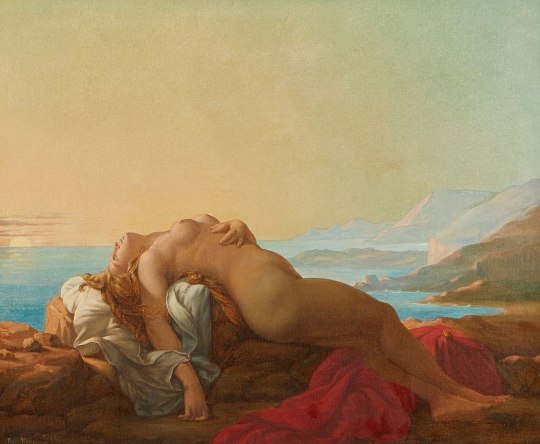
0 notes
Note
Hello! Hi. Hope you guys are doing well. I wanted to ask about referring (pretty blatantly) to autistic characters before autism was a formal diagnosis. One of my characters is nonverbal and autistic and communicates primarily using a notepad (in the Victorian era). Her family (positively coded characters) doesn’t really care or like think negatively of her for being autistic, but they still recognize that she’s not neurotypical, however other characters who appear (not the villains necessarily but negatively coded characters) do care that she’s “abnormal”. Are there any words that really shouldn’t be used to describe her (I have been using ‘odd’ by both groups of characters) or that only one group should use (for example having the ‘mean’ characters use ‘abnormal’ but the ‘nice’ ones use ‘odd’) so I can clearly specify that she is autistic and that it’s not a big deal, while also making sure that the characters who think negatively are portrayed in a negative light (even though they’re not the main villains). While still, not offending anyone or accidentally referring to the character in a pejorative light.
Hi asker,
I'm including some extra context, not just for you the writer, about the Victorian era but also to anyone else reading this ask to learn a little more and maybe be able to apply information to their own characters as well.
The Victorian era is used to refer to the period roughly from 1820 to 1910 in the UK, and often the use of this word for the time is extended to the US as well. Sometimes people use it for other places in Europe, even though Queen Victoria herself only ruled the UK and from 1837 until 1901.
Your character might have been described as 'dumb' or 'mute,' at the time, since she does not speak; for both clarity and reason's sake I would avoid using 'dumb' and only use 'mute' instead. 'Dumb' is, these days, only used as an insult.
Other words people might use for her in the time to denote her as being 'strange' but not necessarily negative might have been (aside from 'strange' and 'odd' that you've already stated): peculiar, eccentric, or unusual. They might use 'queer' as well, as in behaving outside of the norm and not as in gay; that meaning was more by the 1920s.
'Weird' as in "off-puttingly strange" is a more modern word, but it started in the 1820s, so people could conceivably call her weird, especially if they mean to speak ill of her. 'Bizarre' might work, but earlier or in its usage it also had a connotation of unpredictability, too. These two would probably not be used by her family or those who think highly of her, but might be used by people who are fairly neutral on her.
A note on 'moron' and 'imbecile,' which were diagnoses in the early 19th century of intellectual disability but also applied to other people they didn't know how to categorize and could include autistic people: they are definitely used as insults now and were definitely used as insults then when they were diagnoses, but they wouldn't be used on your character because they were not used in that way until the 1910s and 1920s. 'Idiot' is an older word, but it usually was used to refer to people who had more severe intellectual disability; I don't think this would be used for your character much, nor would I recommend it. I don't think it would work to convey what you want the readers to get out of it. Not to mention, it's still very much an insult today.
Now, there's two people from a bit earlier in history who might have been diagnosed as autistic today: Henry Cavendish and Hugh Blair of Borgue. (Obviously we can't know for sure, they've been dead for 200+ years.)
Hugh Blair (wikipedia link) lived from 1708 to 1765. He was described as 'eccentric' and 'daft,' and his behaviors as 'unusual.' He was nicknamed "the daft lad of Borgue." He engaged in a lot of repetitive behaviors, seemed unaware of social norms, and had very strong interests. It's noted that despite being seen as strange, he was generally well-liked.
Henry Cavendish (wikipedia link) lived from 1731 to 1810, so a bit closer to the Victorian era. He was a scientist, a very wealthy man, and notably very shy. He was close basically only to his family, was very solitary, had trouble speaking to others and was noted as wearing old-fashioned clothes. Since he was so solitary, he had trouble publishing his findings, even though he put a lot of work into them. It seems people referred to him as 'solitary' and 'eccentric.'
Some people suggest Emily Dickinson (wikipedia link), who lived from 1830 to 1886, might have been autistic. I am less familiar with her than the above two, but am including her because she is directly in your time period so the way people in her lifetime described her can be relevant. She was very socially isolated, although she was also very affected by deaths around her during her life, and later often ill, which can also be reasons for isolation. She mostly communicated with others via letters in her adulthood. She was seen as an 'eccentric' by others.
I will note that all three of those people were wealthy, so their eccentricities were more tolerated by those around them. A poor person might not have been afforded that second thought.
Now that I've said... all that, I will add my final note:
I think more important than the words themselves is how other characters use the words to describe her.
"Elizabeth is such an odd woman, I should like to write to her and see what she thinks about this" is very different from "Elizabeth is such an odd woman, I can't stand to be around her when she's doing that!" So is "My cousin is a bit peculiar, she does not speak but she can understand you just fine; if you can be patient she will write out her answers" versus "My cousin is incredibly peculiar, she doesn't even speak for goodness's sake! Can you believe it? It's ridiculous."
The way your characters speak about her will not be entirely dependent on the specific words the use, but also in the way they describe her and refer to her. Especially in a time where many things are referred to with euphemisms or vague words (which 'odd' and 'strange' and 'peculiar' definitely are or can be), which the Victorian era absolutely was, both groups of characters can use the same words but their intent can come across due to what else they say about her.
Sorry this is super long, but I hope it helps!
mod sparrow
#autism representation#historical setting#historical fiction#mod sparrow#sorry for typing out worlds longest answer ever
124 notes
·
View notes
Text
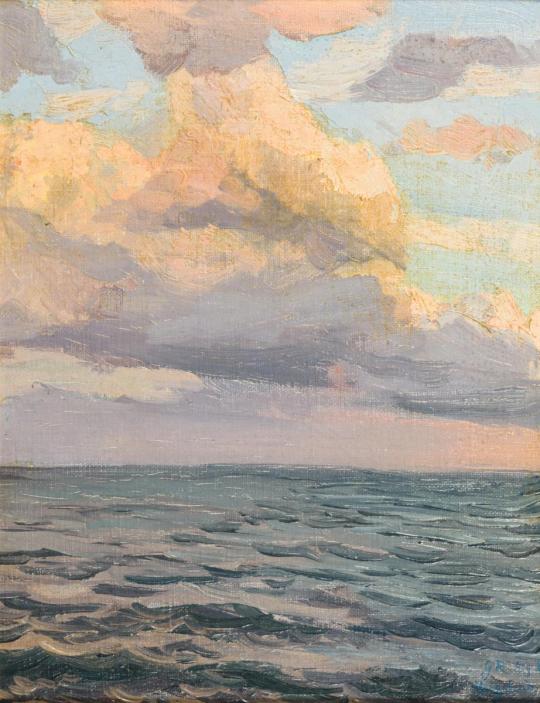
Clouds off Heligoland - Heinrich Ludwig Freiherr von Gleichen-Rußwurm , 1889.
German , 1837-1901
Oil on canvas ,32 x 25 cm.
#Heinrich Ludwig Freiherr von Gleichen-Rußwurm#german artiat#seascape#clouds#North Sea#Heligoland#archipelago
334 notes
·
View notes
Text

Paul Célestin Louis Nanteuil-Leboeuf, 1837-1901
Ariadne abandoned, n/d, oil on canvas, 18x21 3/4 in
Private Collection
254 notes
·
View notes
Text
— A surprisingly long and in depth look about symbolism in the recent G-Fantasy cover by Yana Toboso ✦

Including references, flower language, how to decode the meaning of flowers, and a little too much brainrot. As well my personal interpretation drawn from all the sources I looked at. And of course what all of means (and maybe hints at?) for Sebastian and Ciel… and maybe even Sebaciel?
Originally posted as a twitter thread, but threads suck and I forgot a couple things. so here now.
Disclaimer :
I don’t know FOR SURE that all these things were directly referenced by Yana when creating this art. But being a fan of her work for over a decade I've become familiar with her use of symbolism and reference, and believe myself to have a good eye for it at this point! I'm also pretty familiar with the use of flower language, including different languages, due to having been involved in a project about it and having to read wayyy too much about this.
Some of it also includes my own personal interpretation, but the meanings and info I based myself off of ARE factual. I think I made it pretty clear when referencing my personal interpretation. You're welcome to reach your own interpretation based off of the stuff provided!
And lastly, I'm not a sebaciel shipper. I'm not an anti (the complete opposite, actually) and have nothing against the ship, I like the narrative around them and how they're written but I don’t actively ship them romantically or sexually. So I'd say this is actually a pretty unbiased interpretation. Personal taste is one thing, but I don’t deny the author's intention and whats written in front of me! That is what this post is about.
Kuroshitsuji takes place in the Victorian period (1837~1901) in 1889.
The following are both important Victorian books on the language of flowers that I will be basing myself off of.
Language of Flowers by Greenaway Kate (1884), and The Language of flowers: An Alphabet of Floral Emblems (1857).
(Also, I’m treating Ciel’s rose as a deep red rose. Which is a bit different than red roses. But I am adding some relevant information about roses in general, anyway.
Now, on what they say about these flowers.




Deep rose, meaning "bashful shame". White lily, meaning "Purity and sweetness."
— The White Lily
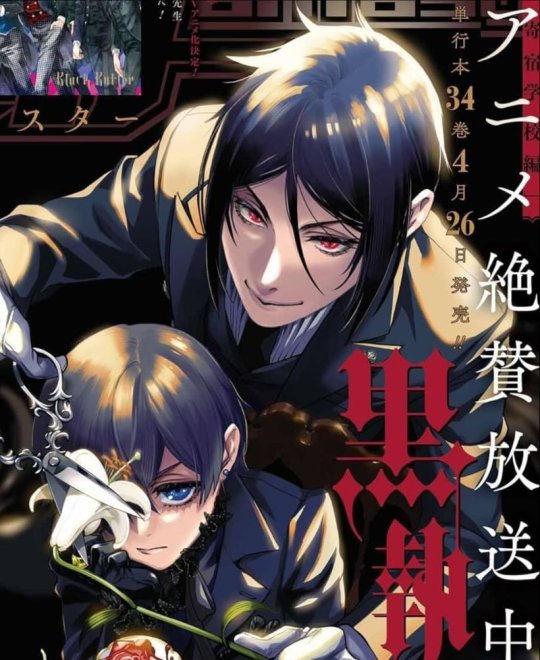
Most people assume that the lily refers to Ciel's purity, and that’s a fair assumption. But I disagree.
Firstly, the one holding the lily is Sebastian. Holding it on his right hand, tilted towards the right. However what's relevant here is the VIEWER. From the viewer's POV he's holding it to the left. Note he also holds the scissors on his left hand, where he bears HIS contract seal.
How you hold a flower, what position you give it to someone in, changes the meaning of the flower. These context clues are very important. It tells us that 'purity and sweetness' doesn’t refer to Ciel, but actually refers to Sebastian (…sorta).

This may be a little confusing. Purity and sweetness, Sebastian?! I know, I know. bear with me.
These books provide poems to help us understand how you may interpret the intended meaning. The lily poem is about enduring trials out of love because of the purity and sweetness he sees in his lover's eyes and soul. I believe Yana directly references the poems I will include in this post in her new artwork.

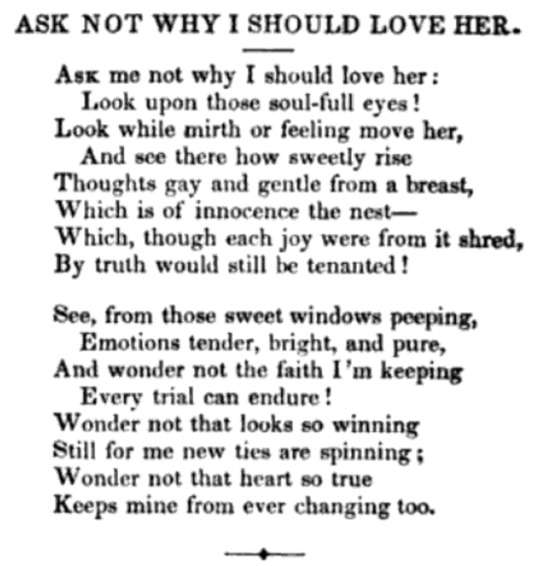
— My Interpretation
the meaning of Sebastian's lily is:

"I do all out of love for the sweetness and purity within you."
Him holding it to the contact seal and cutting the flower could stand for him destroying this sentiment (affection within himself) that has arisen in him as a result of their contract by destroying the sweetness and purity—the source of it—within Ciel (consuming his soul).
Note: This is debatable, as 'reversed' almost always means upside down. But if you consider the lily facing away from the viewer as reversed then it could mean "impurity and bitterness" which fits pretty well with Ciel, and it being held against the contract seal which is a physical representation of his impurity, brought on by his bitterness.

— The Deep Red Rose
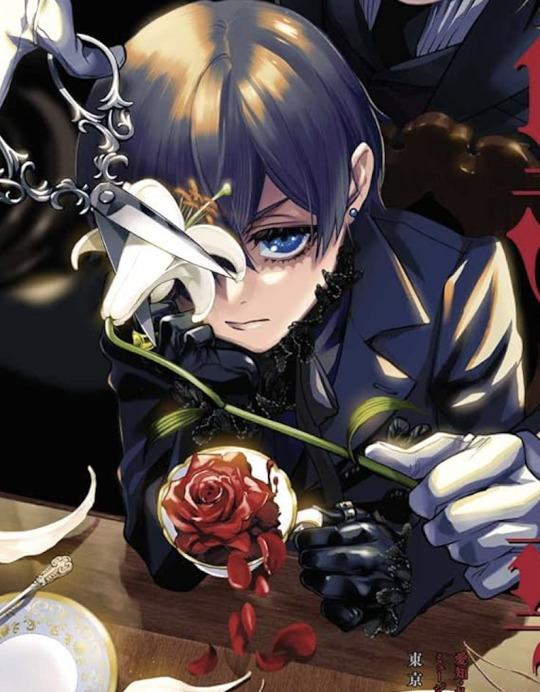
There something I find very interesting. The rose is in a teacup, standing in for tea (I think there's even tea alongside it in the cup.) From Yana herself we know that Sebastian's eyes are a reference to the reddish brown colour of tea.

Like I said, I believe this rose to be a deep red rose, which is a bit more specific than the meaning given to red roses. However I think the poem included for roses in general very much applies here.
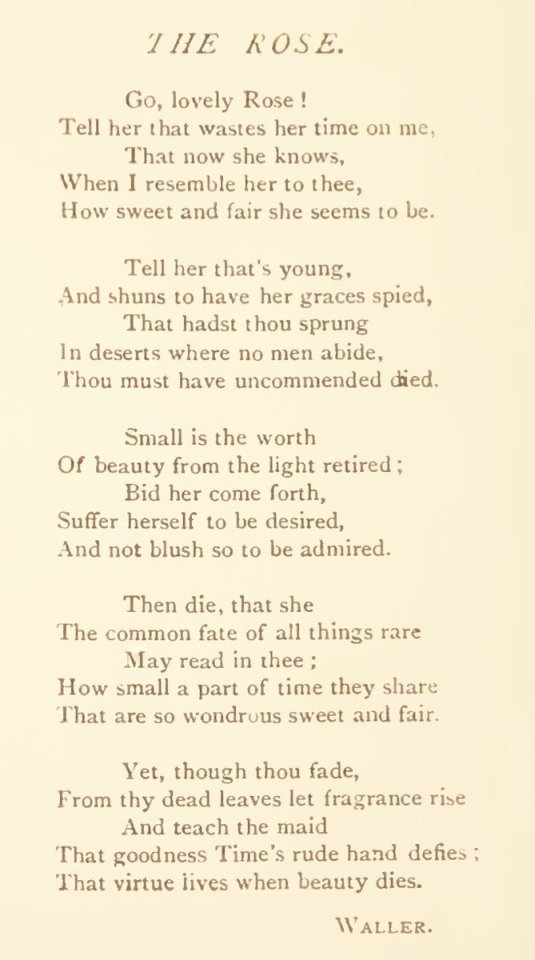
I was going to add my thoughts but I found this interpretation that sums it up pretty well if you replace the carpe diem theme with a more "running out of time" or "impending death" theme, which seems to be a more accurate reading for this artwork.
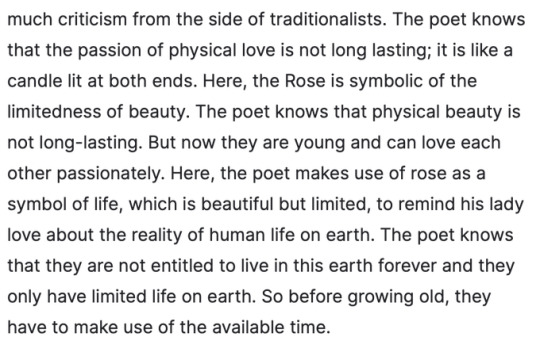
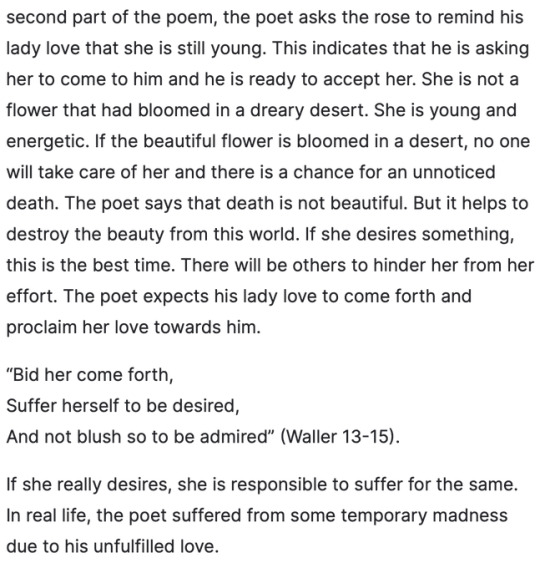
Looking at the rose itself, it has no thorns or leaves.

It is not a youthful rose as its already fully open and losing petals. "No hope, and no fear" fits with the poem, the rose is basically an hourglass referring to Ciel. His fate is unavoidable, but this isn't a deterrent. He's dancing on the ledge.
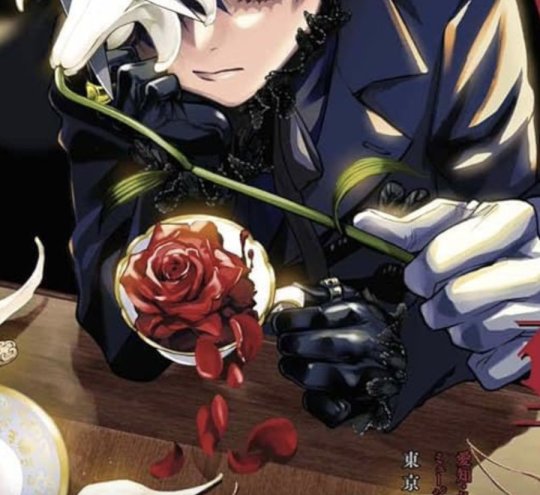
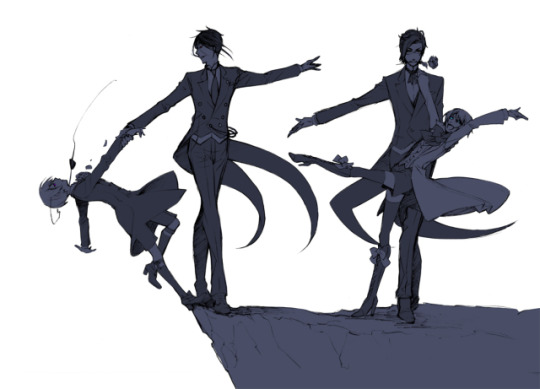
The deep red rose means 'bashful shame'.
When you compare it to the lily, which is a direct proclamation, the deep red rose is a quiet confession one cannot verbalize.
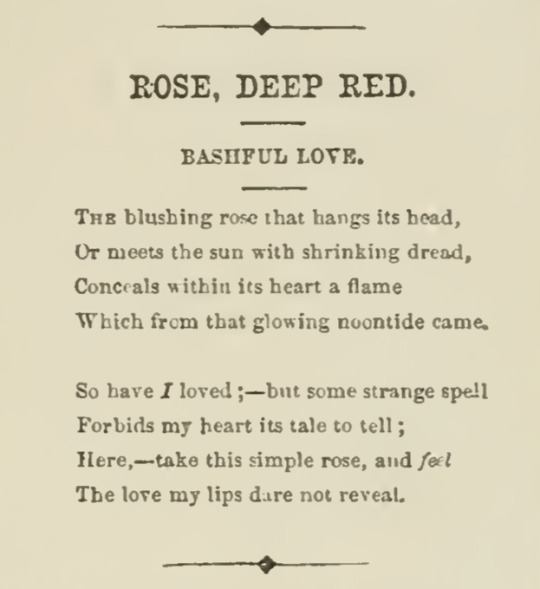
Debatable, to be fair but given the tie in to Sebastian's eye colour and the fact that he is always the one pouring tea for Ciel, I believe the Sebastian to be the speaker here too, but this time speaking on Ciel's feelings (Hence why he's the one holding it) rather than Sebastian's own.
— My Interpretation
The meaning of the deep red rose Ciel holds, speaking about Ciel's feelings of guardedness, and in response saying:
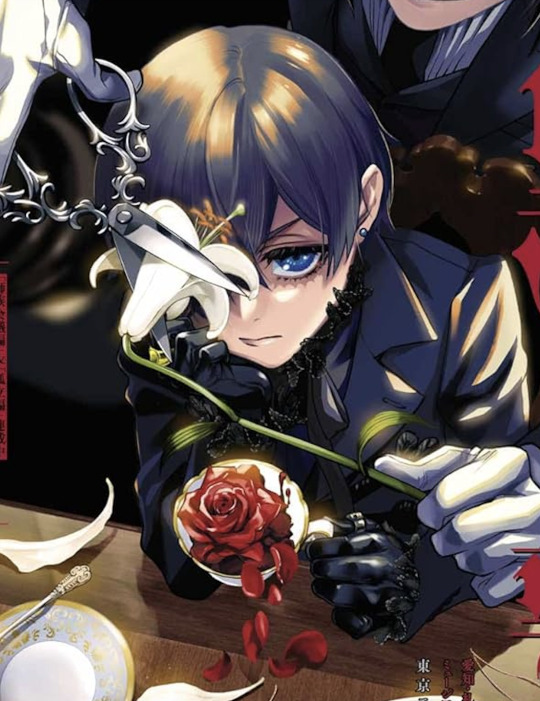
"Abandon your bashful shame, and let yourself be admired without expectations (hope) or fear"
Sebastian speaks about Ciel's feelings, the deep red rose acknowledges his feelings but they remain unspoken.
The Waller poem is a plead for his beloved to seize the day, for time is short, and allow herself to be loved completely.
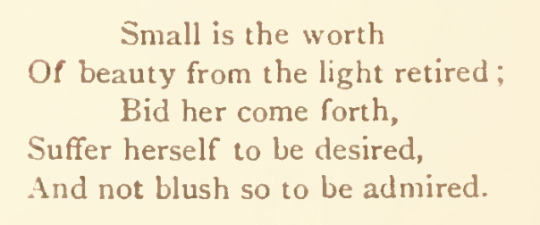
Her beauty is one to be appreciated, she is not meant to be a rose unacknowledged (unloved) in the desert.
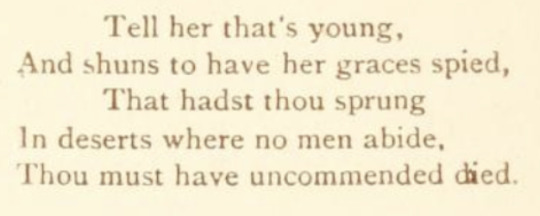
Regarding 'expectations', I think this is more about rigid ideas of how 'appreciation' or 'admiration, might be shown or received. Sebastian and Ciel's relationship defies normality or 'expectations'. So this, too, would defy expectations a young boy like Ciel, or a traumatised boy like Ciel, may have.
From Yana herself, we know Sebastian's dedication and how highly he holds 'beauty', specifically Ciel's beauty.


The author of the poem proclaims that beauty not appreciated is not beautiful indeeed, and so he calls his beloved to come to him and be appreciated wholly during the invaluable, limited time they have.
We see the deep red rose's petals fall away, in my opinion not only symbolising the withering away of time, but also the crumbling away of this "bashful shame" that Sebastian ascribes to Ciel.
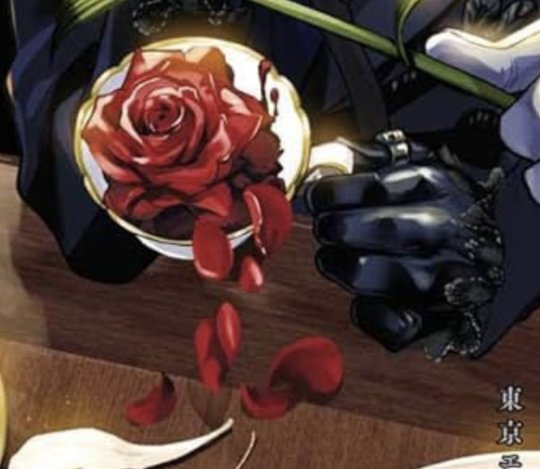
How Sebastian wishes to "appreciate" this beauty is debatable. How he wants to "admire" and "desire" (per the poem) Ciel is rather open ended. Wether it be in a romantic way, a sexual way or by consuming his soul.
However, I don’t think these are mutually exclusive. And consuming Ciel can easily be a metaphor for the former two.
— The Lily and The Rose
The Greeneaway book has this poem which im sure was directly referenced. This poem speaks about the lily and the rose in a direct power struggle and fight for dominance, until they eventually unite and reign as one.
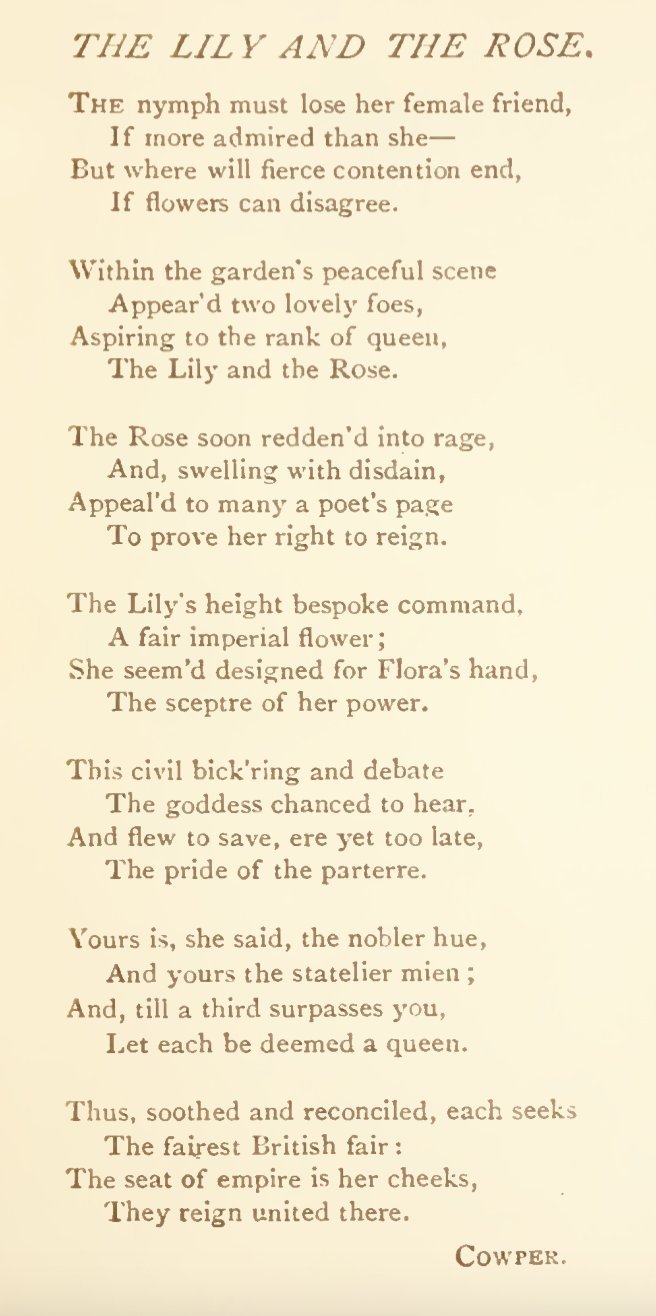
Now when speaking about this "union", you could say it refers to their contract, but I don’t think so.
The contract ties them to each other, but it doesn’t necessarily unite them. So I believe 'unity' to be about the appreciation Sebastian speaks of Ciel opening up to.
"The Lily" and "The Rose" might be interpreted as directly representing Sebastian and Ciel, and the unity that would come from them joining and becoming a truly complimentary pair. I think a power struggle and fight for being the one in control is very accurate way to describe their current dynamic in canon.
It may also be interpreted as "The Lily" and "The Rose" as being representations of their feelings and ideals previously. And then it would represent these two conflicting expressions—a loud unrelenting and destructive devotion, and a guarded, bashful, unspoken reluctance— coming together and turning from conflicting to complimentary.
Or as it tends to be with these things, both!
Either way all of this is expressed under the sense of impending doom created by their circumstances and the contract. So there's a sense of urgency permeating all of it.
Also clear to me is a sense of internal conflictedness coming from Sebastian's message that is usually only hinted at like this, and some people end up overlooking.
Sebastian desires Ciel deeply, but having him would also mean not being able to have him anymore.
Sebastian is torn and that’s why he attempts to cut the root of his wavering feelings represented by the lily.
All of this makes me wonder about what's next, and if we will see these things said more blatantly. Foreshadowing with flower language and references like this, isn't exactly rare for Yana. I wonder if we will see this 'unity' come to be, and what necessary development Sebastian and Ciel will need to undergo to make it possible. As well as what shape it will take.
I also wonder very much about Ciel's perspective in all of this, as this was almost entirely from Sebastian's POV, but I think that's intentional. Ciel has his own goals and a lot on his mind. Sebastian's goal IS Ciel. So I assume he spends a lot more time thinking about Ciel and this kind of thing.
Thank you if you read the whole way through. Like I said before, even though the sources defending it are, my interpretation is not law and you're welcome to reach your own with the things presented.
Links for sources, including free public domain PDFs of the books mentioned are found at the end of my twitter thread.
— Thanks for reading! —

#sebaciel shipper friendly post#kuroshitsuji#black butler#sebastian michaelis#ciel phantomhive#sebastian black butler#ciel black butler#sebaciel#please refrain from ship discourse on my post. I don't care if fictional characters upset you. I'm looking at the source material here.
348 notes
·
View notes
Text



This post translates directly to @musas-sideblog's about how Touchstarved ties with Victorian horror and implicit/metaphorical sex, and I couldn’t stop thinking about it, so here is a lengthy theory. Enjoy :)
Note 1: Victorian era authors used an unholy amount of ways to imply sexual feelings/acts etc, so I here I will include only the ones that are of interest. Note 2: I've highlighted the "most important" parts. Note 3: I'm not an expert at this, so please bear with me and feel free to correct me. Note 4: Do I need to add a TW? I think it's obvious-

Overview: What is Victorian Horror?
Victorian horror refers to the genre of horror literature, art, and culture that flourished during the Victorian era, roughly from the mid-19th century to the early 20th century, coinciding with Queen Victoria's reign from 1837 to 1901. This period was marked by a fascination with the macabre, the supernatural, and the dark aspects of human nature, reflecting the anxieties and societal changes of the time.
Key Themes and Characteristics
Supernatural Elements:
Ghosts and Spirits: Tales of haunted houses and spectral apparitions were central to Victorian horror. Charles Dickens's "A Christmas Carol" (1843) and Henry James's "The Turn of the Screw" (1898) are notable examples.
Monsters and the Gothic: The era's literature is filled with monstrous creations and gothic settings, such as in Mary Shelley's "Frankenstein" (1818), Bram Stoker's "Dracula" (1897), and Robert Louis Stevenson's "Strange Case of Dr Jekyll and Mr Hyde" (1886).
Science and the Unknown:
The Victorian period was a time of great scientific advancement, but also of fear about the implications of these discoveries. This is evident in works that explore the dangers of unchecked scientific experimentation, like "Frankenstein" and H.G. Wells's "The Island of Doctor Moreau" (1896).
Exploration of the Human Psyche:
Victorian horror often delved into the darker aspects of the human mind, including themes of duality, madness, and the hidden, sinister side of human nature. This is seen in "Dr Jekyll and Mr Hyde" and Edgar Allan Poe’s works, such as "The Tell-Tale Heart" (1843).
Social and Moral Anxieties:
The literature frequently reflected Victorian society's fears and anxieties, including issues related to sexuality, class, and the role of women. Gothic novels often contained subtexts about societal norms and the consequences of transgressing them.
Urban Fear and Isolation:
The rapid urbanisation of the Victorian era contributed to themes of isolation, alienation, and fear of the crowded yet lonely cityscape. This is evident in the settings of many horror stories, such as Arthur Machen's "The Great God Pan" (1894).
Sexual Content: Victorian literature is renowned for its strict moral codes and conservative views on sexuality. Explicit depictions of sexual activity were considered taboo and were subject to censorship. Consequently, authors developed subtle and nuanced methods to imply sexual scenes or themes.
Literary Techniques for Implying Sexual Scenes
✧ Symbolism and Imagery:
Sexuality was often conveyed through symbolic imagery. Objects, actions, or natural phenomena could serve as metaphors for sexual activity or desire. For example, in "Dracula" by Bram Stoker, blood and biting symbolise sexual penetration and the exchange of bodily fluids, infusing the act with a sense of forbidden desire and eroticism.
Clothing and Undress:
Gloves: In Victorian culture, gloves were highly symbolic. The act of a woman removing her gloves in the presence of a man, or a man assisting her in this act, could signify a moment of intimacy or vulnerability. Similarly, a man giving a woman his gloves could be a sign of affection or a deeper connection.
Hats and Bonnets:
Corsets
Objects and Personal Items:
Locks of Hair
Jewellery
Books and Letters
Touch and Physical Contact:
Kissing Hands
Hand-Holding
Food and Drink:
Wine: Sharing wine or a meal in an intimate setting often suggested a prelude to deeper connection. Descriptions of characters drinking wine together in private could imply a romantic or sexual undertone.
Fruit: Certain fruits, like apples, grapes, or peaches, were laden with sexual symbolism. Eating or sharing fruit could represent temptation or indulgence. For instance, in Christina Rossetti’s poem "Goblin Market", the act of eating the goblin fruit is rich with sexual symbolism.
Flora and Fauna
Flowers and Gardens:
Roses: Roses were often used to symbolise love and passion. A red rose might suggest romantic or sexual attraction, while a wilted rose could imply lost innocence or sexual ruin.
Lilies: Lilies, especially white ones, represented purity but could also suggest a contrasting theme when associated with a fallen or tarnished character.
Garden Settings: Scenes set in secluded gardens or amongst lush, overgrown vegetation often hinted at secret or forbidden encounters. Descriptions of characters wandering through or tending to gardens could imply sexual exploration or awakening.
Flowers Blooming or Opening: The blooming of flowers often represented sexual awakening or the act of losing one's virginity.
Nature Imagery:
Rivers and Water: Flowing water and rivers often symbolised sexual desire and the act of lovemaking. For instance, in "Tess of the d'Urbervilles" by Thomas Hardy, Tess's encounter with Alec d'Urberville is often described with metaphors of nature and fluidity.
Storms and Weather: Storms, with their intense energy and sudden outbursts, were frequently used to symbolise sexual passion or climactic moments.
Birds and Beasts:
Animals, especially those that are wild or predatory, often symbolised primal sexual instincts and desires. The taming or interaction with these animals could imply a character’s grappling with their own sexuality.
Fire and Heat
✧ Phrases and Sayings
Euphemistic Language
Descriptive Phrasing
Dialogue and Confessions
Private Spaces:
Secluded or Dimly Lit Rooms: Scenes set in private, darkened rooms often suggested clandestine sexual encounters. The privacy of the setting allows authors to imply what could not be explicitly stated. In Wilkie Collins’s "The Woman in White", many key interactions happen in secluded spaces, hinting at secrets and hidden desires.
Dreams and Fantasies:
Dream Sequences:
Dreams and fantasies were used to explore a character’s subconscious desires and fears, often revealing their suppressed sexual longings. These sequences provided a socially acceptable way to delve into erotic themes.
Hallucinations and Madness:
Moments of madness or hallucination could serve as a metaphor for overwhelming passion or uncontrollable sexual desire. These states allowed characters to express forbidden feelings in a way that was metaphorically safe.
Physical Interactions and Horror
Touch and Proximity as Menace:
Unwanted or Forced Touch: In horror, touch that is typically a sign of affection or intimacy becomes a source of fear.
Physical Closeness in Horror Settings: Close proximity in dark, secluded places amplifies the sense of claustrophobia and vulnerability, turning what could be an intimate setting into one fraught with terror.
Undress and Exposure in Horror:
Loosening Corsets and Vulnerability: The act of undressing or loosening clothing, which can be a prelude to intimacy, in horror often leaves characters vulnerable to attack or exposure of their deepest fears.
Food and Consumption in Horror
Cannibalism and Vampirism:
Blood as Sexual and Vital Fluid: The act of consuming blood, as in vampirism, blends the themes of sustenance and sexual exchange. The vampire's bite becomes a metaphor for both sexual penetration and the transfer of life force.
Example: "Dracula" is a prime example where blood consumption is deeply eroticized, with Dracula’s victims often portrayed in a state of ecstatic submission as he drains their blood.
Food as a Lure: Food and feasting, typically symbols of pleasure and indulgence, in horror contexts can be used to lure victims into dangerous situations.
Example: In "Goblin Market" by Christina Rossetti, the goblins’ fruit is both irresistibly tempting and dangerous, representing a forbidden and potentially fatal indulgence.
Plot and Character Dynamics in Horror
Power and Domination:
Common Dynamics with a Dark Twist
Predators and Victims: Characters who prey on others are often literal monsters in horror, representing the loss of control or innocence.
Secrecy and Concealment:
Hidden Desires and Monstrous Revelations: Characters who conceal their true identities or desires often find these hidden aspects manifesting as monstrous or terrifying in horror narratives, suggesting that repression can lead to dire consequences.
Clandestine Meetings and Forbidden Encounters: Secret meetings and forbidden relationships, often tinged with sexual implications, add an element of danger and fear, suggesting that transgressing social norms leads to horror.
Common Themes in Victorian Horror
Duality and the Doppelgänger:
Theme: The concept of duality, where a character has a hidden, darker side, or encounters a double (doppelgänger), often symbolises the internal conflict between good and evil within individuals.
Connection: This theme reflects Victorian anxieties about identity, morality, and the consequences of repressing one’s darker impulses.
Gothic and Supernatural Elements:
Theme: Victorian horror is rich with Gothic elements such as haunted houses, dark landscapes, and supernatural beings. These elements create a sense of dread and evoke the mysteries of the unknown.
Connection: The Gothic setting often serves as a backdrop for exploring human fears, isolation, and the impact of the supernatural on everyday life.
Decay and Degeneration:
Theme: The fear of decay and degeneration, both physical and moral, is a recurring motif. This theme often examines the decline of individuals, families, or societies and the consequences of corruption and vice.
Connection: This theme mirrors Victorian concerns about the erosion of social and moral values amidst rapid industrial and social changes.
Madness and Psychological Horror:
Theme: The exploration of madness and psychological horror delves into the fragility of the human mind and the terror of losing one's sanity. This often includes hallucinations, obsessions, and the thin line between reality and delusion.
Connection: This theme resonates with Victorian fears of mental illness, the limitations of medical knowledge, and the impact of societal pressures on mental health.
Forbidden Knowledge and the Faustian Bargain:
Theme: The pursuit of forbidden knowledge and the resulting consequences is a central theme. Characters who seek power, immortality, or forbidden truths often pay a heavy price, reminiscent of the Faustian bargain.
Connection: This theme highlights Victorian anxieties about scientific progress, moral boundaries, and the potential hubris of human ambition.
The Uncanny and the Unknown:
Theme: The uncanny involves the strange and unfamiliar becoming eerily familiar, often unsettling the reader and characters. It blurs the lines between reality and the supernatural, invoking fear and discomfort.
Connection: This theme taps into Victorian fears of the unknown, the foreign, and the otherworldly, reflecting broader anxieties about social and cultural boundaries.
Death and the Afterlife:
Theme: Victorian horror frequently grapples with themes of death and the afterlife, exploring the fear of mortality, the possibility of an afterlife, and encounters with the dead or undead.
Connection: These themes reflect Victorian preoccupations with death, the spiritual realm, and the possibility of life beyond death, often intensified by the era's high mortality rates and interest in spiritualism.
Isolation and Alienation:
Theme: Isolation and alienation are prevalent themes, often highlighting characters who are physically or emotionally detached from society, leading to their vulnerability and descent into despair or madness.
Connection: This theme resonates with the Victorian experience of industrialization and urbanization, which often led to feelings of disconnection and loneliness.
Class and Social Anxiety:
Theme: Victorian horror often explores themes of class and social anxiety, including the fear of losing social status, the consequences of poverty, and the tension between different social classes.
Connection: This theme reflects the rigid class structures of Victorian society and the fears and tensions that arose from social mobility and economic disparity.
Moral Corruption and Hypocrisy:
Theme: Victorian horror frequently critiques the era’s moral standards and exposes the hypocrisy of societal norms. Characters who appear virtuous often harbor dark secrets or engage in morally dubious activities.
Connection: This theme mirrors the Victorian concern with appearances and the underlying tension between public propriety and private desires.
The Five Pillars of Victorian Horror & The Five Love Interests
The Supernatural and the Gothic (Ais)
Essence: Victorian horror often revolves around the supernatural, blending Gothic elements to evoke a sense of dread and otherworldly terror. This includes ghosts, vampires, haunted houses, and curses, which create an atmosphere where the boundaries between the natural and the supernatural blur.
Impact: The use of Gothic settings and supernatural phenomena provides a backdrop for exploring deeper themes of fear, mortality, and the unknown.
Psychological Depth and Madness (Vere)
Essence: Victorian horror delves into the complexities of the human mind, exploring themes of madness, obsession, and the psychological effects of fear and trauma. Characters often grapple with their sanity, facing inner demons as terrifying as any external threat.
Impact: This focus on psychological horror allows for a deeper exploration of character motivations and the impact of societal pressures.
Moral Corruption and the Double Life (Leander)
Essence: Themes of moral corruption and the duality of human nature are central to Victorian horror. Characters often lead double lives, presenting a veneer of respectability while concealing dark, sinful secrets. This tension between outward appearances and hidden truths reflects the era’s social hypocrisy and fear of scandal.
Impact: These themes critique Victorian society’s emphasis on propriety and the dangerous consequences of repressing one’s true nature. The idea of a double life or hidden self adds to the horror by suggesting that evil can reside within anyone, masked by a facade of normalcy.
Decay, Degeneration, and Disease (Kuras)
Essence: The themes of physical and moral decay, societal degeneration, and disease permeate Victorian horror. These motifs symbolise the fragility of human life and the inevitability of decline, reflecting the anxieties of a society grappling with rapid change and uncertain futures.
Impact: By focusing on decay and degeneration, Victorian horror underscores the transient nature of life and the ever-present threat of corruption and decline, whether through ageing, moral compromise, or societal breakdown.
Isolation and Alienation (Mhin)
Essence: Isolation and alienation are pervasive themes in Victorian horror, often depicted through characters who are physically or emotionally cut off from society. This separation heightens their vulnerability to external threats and internal fears.
Impact: Isolation serves to intensify the psychological tension and sense of dread, as characters confront their fears alone. It also reflects the era’s social and existential anxieties, including the fear of being disconnected or outcast from society.

Generally, I believe each LI connects with a pillair (as seen above). Perhaps by looking at the archetypes we could deduce propable endings and route elements.
Forgive me, for the following part is MESSY;
Ais
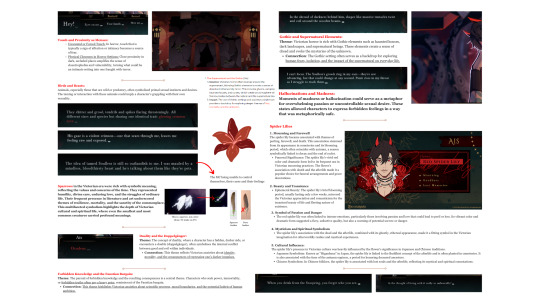
Vere
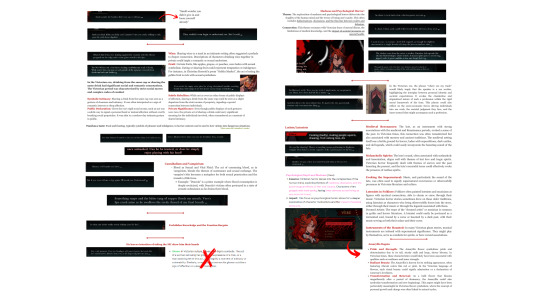
Leander
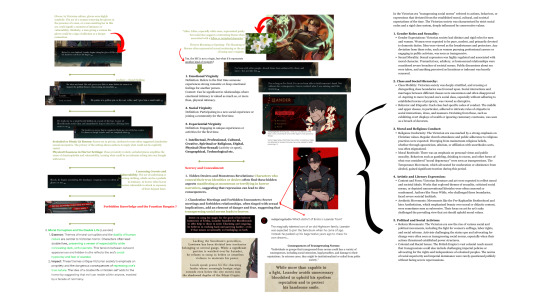
Kuras

Mhin


#THIS TOOK ME AGES#but it was worth it#vereletters#touchstarved theory#touchstarved theories#touchstarved ais theory#touchstarved vere theory#touchstarved kuras theory#touchstarved leander theory#touchstarved mhin theory#red spring studios#touchstarved#ts#touchstarved headcanons#touchstarved game#touchstarved oneshot#ais#ais headcanons#ais ts#ts ais#ais touchstarved#touchstarved ais#ais oneshot#vere#vere headcanons#vere ts#ts vere#vere touchstarved#touchstarved vere#vere oneshot
218 notes
·
View notes
Text
IGOT IT I GOT IT I GOT IT I KNOW HOW TO FIND THE CODES
There are three types of flowers in each of the storybooks and the album cover
You can identify them using the floriography cards
THEN USE ACTUAL FLORIOGRAPHY FOR THE SECRET CODES
47 notes
·
View notes
Text
newsies fandom I love you dearly, but why do we reference the time period that newsies takes place in as the 'Victorian Era" when we have another term that quite literally describes the period of history and the place that newsies is set in?
If you didn't know, the Victorian Era is tied directly to the history of Great Britain and coincides with Queen Victoria's reign from 1837 to 1901. It was a time of social reform and significant advances in science and technology.
In the United States, we have a term that refers to the period after the American Civil War or the 1870s to 1890s. This term is the "Gilded Age". The Gilded Age in US history was so named because it was a time of political corruption and serious social problems (like child labor, poverty, and Jim Crow laws) thinly veiled or "gilded" by a golden mask of economic expansion and industrialization.
The newsboys' strike of 1899 was set against the backdrop of the Gilded Age, not the Victorian Era. It might seem like a small thing to nitpick, and both periods bare resemblance to each other, but I swear it's so important when looking at the history and the context of the time.
87 notes
·
View notes
Text


It was, in fact, one of the pieces his father had wooed his mother with, before they were married. Jem's father was the romantic, his mother more practical, but the music had moved her nonetheless. His father had insisted Jem learn it - "I played it for my bride, and one day, you will play it for yours."
Jonah Carstairs & Ke Wen Yu from The Shadowhunter Chronicles
Since Jonah hails from England during the Victorian era (1837–1901) and Ke Wenyu comes from China, also in the same period, during the Qing Dynasty (1644–1912).
#jonah carstairs#ke wen yu#ke wenyu#jem carstairs#ke jian ming#tidedit#the infernal devices#shadowhunters#shadowhuntersedit#carstairs family#ke family#victorian era#qing dynasty
35 notes
·
View notes
Text
Donald
1 George Washington 1732-1799 Indépendant 1789-1797
2 John Adams 1735-1826 Parti fédéraliste 1797-1801
3 Thomas Jefferson 1743-1826 Parti républicain-démocrate 1801-1809
4 James Madison 1751-1836 Parti républicain-démocrate 1809-1817
5 James Monroe 1758-1831 Parti républicain-démocrate 1817-1825
6 John Quincy Adams 1767-1848 Parti républicain-démocrate 1825-1829
7 Andrew Jackson 1767-1845 Parti démocrate 1829-1837
8 Martin Van Buren 1782-1862 Parti démocrate 1837-1841
9 William Henry Harrison 1773-1841 Parti whig 1841
10 John Tyler 1790-1862 Parti whig 1841-1845
11 James Knox Polk 1795-1849 Parti démocrate 1845-1849
12 Zachary Taylor 1784-1850 Parti whig 1849-1850
13 Millard Fillmore 1800-1874 Parti whig 1850-1853
14 Franklin Pierce 1804-1869 Parti démocrate 1853-1857
15 James Buchanan 1791-1868 Parti démocrate 1857-1861
16 Abraham Lincoln 1809-1865 Parti républicain 1861-1865
17 Andrew Johnson 1808-1875 Parti démocrate 1865-1869
18 Ulysses Simpson Grant 1822-1885 Parti républicain 1869-1877
19 Rutherford Birchard Hayes 1822-1893 Parti républicain 1877-1881
20 James Abram Garfield 1831-1881 Parti républicain 1881
21 Chester Alan Arthur 1829-1886 Parti républicain 1881-1885
22 Grover Cleveland 1837-1908 Parti démocrate 1885-1889
23 Benjamin Harrison 1833-1901 Parti républicain 1889-1893
24 Grover Cleveland 1837-1908 Parti démocrate 1893-1897
25 William McKinley 1843-1901 Parti républicain 1897-1901
26 Theodore Roosevelt 1858-1919 Parti républicain 1901-1909
27 William Howard Taft 1857-1930 Parti républicain 1909-1913
28 Woodrow Wilson 1856-1924 Parti démocrate 1913-1921
29 Warren Gamaliel Harding 1865-1923 Parti républicain 1921-1923
30 Calvin Coolidge 1872-1933 Parti républicain 1923-1929
31 Herbert Clark Hoover 1874-1964 Parti républicain 1929-1933
32 Franklin Delano Roosevelt 1882-1945 Parti démocrate 1933-1945
33 Harry S. Truman 1884-1972 Parti démocrate 1945-1953
34 Dwight D. Eisenhower 1890-1969 Parti républicain 1953-1961
35 John Fitzgerald Kennedy 1917-1963 Parti démocrate 1961-1963
36 Lyndon Baines Johnson 1908-1973 Parti démocrate 1963-1969
37 Richard Milhous Nixon 1913-1994 Parti républicain 1969-1974
38 Gerald R. Ford 1913-2006 Parti républicain 1974-1977
39 Jimmy Carter 1924-2024 Parti démocrate 1977-1981
40 Ronald Wilson Reagan 1911-2004 Parti républicain 1981-1989
41 George Herbert Walker Bush 1924-2018 Parti républicain 1989-1993
42 Bill Clinton*1946 Parti démocrate 1993-2001
43 George W. Bush*1946 Parti républicain 2001-2009
44 Barack Hussein Obama II.*1961 Parti démocrate 2009-2017
45 Donald John Trump*1946 Parti républicain 2017-2021
46 Joseph “Joe” Robinette Biden, Jr.*1942 Parti démocrate 2021-2025
47 Donald John Trump*1946 Parti républicain 2025-2029
37 notes
·
View notes
Text

Queen Victoria, 1819 - 1901. Reigned 1837 - 1901
Artist: Alfred Edward Chalon (Swiss, 1780-1860)
Date: 1838
Medium: Watercolour on paper
Collection: National Galleries of Scotland, Edinburgh, Scotland
Description
Born at Kensington Palace, the only child of the Duke of Kent and Princess Victoria of Saxe-Coburg, Queen Victoria succeeded to the throne on the death of her uncle, William IV. Not only did she become the longest reigning British monarch but she was also the figurehead of a vast empire. In 1840 she married her cousin, Albert of Saxe-Coburg and Gotha, and their happy marriage brought forth a family of nine children. After Albert’s death she largely retired from public life and spent much of her time at Balmoral in Scotland. This delicate watercolour by Chalon was the very first portrait the young queen sat for after her accession to the throne. She is dressed in the robes she wore when Parliament was dissolved after her uncle’s death, her hat casually discarded on the floor.
#portrait#watercolour#queen victoria#british monarchy#british empire#artwork#fine art#british royal family#british history#full length#seated#chair#costume#architecture#foliage#hat#courtyard#urn#necklace#swiss culture#swiss art#alfred edward chalon#swiss painter#european art#19th century painting#national galleries of scotland
27 notes
·
View notes